ARTICLE No. 240
Ronald J. Jack
Public Historian and Web-Publisher
Woven cap badge of the U.S. Paratroops - WW2
In 1968 David L. Wolper produced a war movie that delivered a safe dose of vicarious military adventure to young schoolboys across Canada and the United States. In Saint John I was one of those kids who went "uptown" to see THE DEVIL'S BRIGADE, a highly fictional drama inspired by the real exploits of the First Special Service Force (1st SSF). Canadians are very touchy about the American habit of taking full credit for winning both world wars, so it was a thrill to see our soldiers portrayed in such a positive light. No sooner has the Regimental C.O. delivered the line, "You Canadians I'm told, are the hand picked best, of the best trained army in the world. We'll soon find out about that," ... than a "Sergeant O'Neil" of the P.P.C.L.I., (a hand-to-hand combat instructor) walks into the mess-hall and wipes the floor with an American G.I. goon. We youngsters loved it and cheered! Years later I acquired the official history of the 1st S.S.F. and, searching through the Regiment's nominal roll, discovered that several men from New Brunswick had served in the Force, including a few from my school - Saint John High. That was satisfying in itself, but it never dawned on me that other men from our province might have served in elite units of the American Armed Forces. Today I would like to share the story of just one of those brave men from Saint John.
Jim Welsh has been a pen-friend of mine for almost seven years, and I have used some of his recollections in other Blog articles. He is a friend I enjoy, and today I want to take readers deeper into his interesting life. Jim is the man I like to call "The Paratrooper from Main Street".
THE DEVIL'S BRIGADE played at the ODEON THEATRE'
on King Square. We schoolboys howled in support of the
Canadian heroes portrayed in the Hollywood movie.
Jim Welsh has been a pen-friend of mine for almost seven years, and I have used some of his recollections in other Blog articles. He is a friend I enjoy, and today I want to take readers deeper into his interesting life. Jim is the man I like to call "The Paratrooper from Main Street".
"An American by birth and most of my life, I only lived in Saint John nine years (1933-1942) with another year in Truro, N.S., yet I look on those years as my 'most formative' having attended Grades 2 through High School there. And I look on the period as quite dramatic, for Saint John itself as everyday life morphed into the Second World War, only a few months after the [1939] Royal Visit."
James "Jim" Welsh enjoyed an eventful and productive life, and having lived longer than most, he has had time to sort through the experiences and friendships that formed his personality and forged his character. In the seven years that we have corresponded, Jim frequently recalls his happy family life in a tenement in the North End of Saint John.
"I lived the nine years at 400 Main Street - just across the street from St. Luke's Church (when it had the steeple!) - between Harrison Street and Murray Street, where the public stairs ran down to the latter - Quinn's Plumbing directly across the street - and streetcars the primary form of public transportation. I played in St. Mary's Band, attended St. Mathews Presbyterian Church and graduated from 'Voc' ! "
The Drum and Bugle Band at Saint John Vocational High School wore a
blue uniform during W.W. 2. The band was under the capable instruction
of Major Gordon Lordly, a veteran of WW1. Mr. Lordly established the
curriculum for the Electrical Department. and was its head teacher.
VOC'S "DRUM AND TRUMPET" BAND
Jim Welsh was an active member of the Vocational School marching band - the Drum and Trumpet Band. "As best I recall, we went by that name, Drum and Trumpet...not Drum and Bugle, as most are called." He sent a photograph of the band, accompanied by depth of recollection that is rarely encountered for a man in his ninth decade. "Those white belts were not originally part of the uniform; I saw them and bought one in Woolworth's on King Street and sold the idea to Mr. L and the band. They came from the Ladies Department and were shiny white and made of some plasticky/vinyl material. I think the square-knot trim along the bottom of the snare drums were both my idea and my handiwork. I've done a fair amount of square-knot (and variation) decorative work through the years."
Another memory I recall quite clearly... the band's Bass Drum (not visible in the picture) was bought and donated by a civic group, I'm pretty sure was the Kiwanis. I was chosen to attend a luncheon at one of the hotels uptown, and formally accepted the drum... big deal ! I must have been a sight parading all alone, carrying that big drum from uptown, over to the North End, walking up Main Street and out Douglas Avenue to Voc! As well as playing our instruments, the band was taught Semaphore (flag) Signalling by a squat and chubby uniformed Regular Army or Reserve soldier. Just who taught us the musical selections we played, I DON'T recall ! But as I remember, we were said to be pretty good. ... So it's more than a photograph to me! "
[Request - I would like to add a photograph of Major Gordon Lordly to this article. For that we rely on some kind reader to scan and email an image to the L.V. Blog. - R. Jack]
"I studied drafting at 'Voc' with idea of going on to either Marine or Aeronautical Engineering. My first real job was as a draftsman at T.S. Simms, on the recommendation of W.B. Main, Voc's Director. Soon however, I was at Washington, D.C. as a draftsman for the Navy Department, with a string of deferments that probably would have kept me out of the war. Nonetheless Duty callled. I waived deferments and enlisted - maybe to impress my girlfriend - I just don't know."
During the war, as Jim Welsh moved by ship and aircraft from one battle zone to another, Saint John, New Brunswick remained his frame of reference, and thoughts of friends and family "back home" anchored him emotionally, as he he encountered a European continent torn to shreds by war. For a sample of what I refer to, read his anecdote "Memories of an Art Teacher" in Blog No. 234. In retirement, Jim wears a Saint John Vocational class ring, a treasured keepsake passed on by his cousin Audrey.
In 1976 Jim Welsh returned to Saint John, to visit family and refresh
his precious memories of streets and neighbourhoods in the old North End.
400 Main Street was gone, and lacking a photo of their house (it fell to Urban
Renewal) he drew it from memory. I was pleased to be able to send him a
photo of the building, which confirmed the clarity of his recollection.
The story of Jim's return visit to Saint John is found in Blog Article 93,
THOSE MURRAY STREET STAIRS - A Century of Service
The story of Jim's return visit to Saint John is found in Blog Article 93,
THOSE MURRAY STREET STAIRS - A Century of Service
In an early email, Jim tied up his whole war adventures and postwar experiences in a single paragraph:
"Passing up enticements to join the (then) Army Air
Corps (and I loved airplanes!) and early commission as an officer, I
volunteered for Infantry -- Airborne (Parachute) Infantry at that! I
went overseas as a paratrooper, missed Normandy but jumped into Southern France
in August 1944 and saw the war to its end, plus early occupation of Germany with
airborne units. Mum having died within days of the war's end, I had
little need or desire to return to Canada nor the USA, so reenlisted,
married an English girl I'd met while hospitalized (minor hand wound) in
England, brought her to Germany, had first two of three children, remained
overseas until 1952, returned to the States and two years later was
"conned" back to civilian life by an old friend with the promise of
Life on a Silver Platter which, as silver does, tarnished! Enough of that
story -- except to say I never truly or seriously went back to drafting. Oh, I
came out of service as a Master Sergeant -- top NCO rank at the time. Oh, and
should add: about 4 years of my 11 in the Army was spent in either Signal or
Adjutant General (Administrative) duties, not Airborne or Infantry.
I intended to make a career of the military -- but that Silver Platter seduced
me! Bad choice? Yes, but I pay little attention to spilt milk! "
His modesty was doing himself and his career a disservice.
The 551st and OPERATION DRAGOON
Jumping into a war zone is certainly a dramatic and very lethal opening gambit, but to win the field Allied forces had to be expert in their jobs, and unit commanders had to coordinate the seizure of a number of key objectives in sequence, while building a forward momentum that would demoralize the enemy and roll them back. The D-Day landings in Normandy had opened the Second Front, but much of Southern Europe remained thick with Axis Forces, and they were more than capable of mounting a counter-strike. The decision was made to mount a second invasion of France, from the south.
"The Airborne portion of the Southern France Invasion was carried out by a quickly-formed and temporary "First Airborne Task Force" composed of several other "independent units", including the US/Canada Special Service Force, a British Brigade, the 509, 517, 551st and others."
Each soldier in the paratroops had a combat specialty, beyond the fact that they were all qualified jumpers. He was trained on mortars. "Each company of an Airborne Regiment had an 81 mm Mortar Platoon consisting of four mortars and crews." As Jim reminisced in a series of emails, I sent him a photograph of the 551st taken as they were dropping from C-47 transports on August 15, 1944 - the kickoff to OPERATION DRAGOON. I knew that he would have seen it before, but simply wanted his response to the image. His comments underscore the risks, as well as the bravery of soldiers dropping in on the veteran units of the German Wehrmacht.
The 551st and OPERATION DRAGOON
Jumping into a war zone is certainly a dramatic and very lethal opening gambit, but to win the field Allied forces had to be expert in their jobs, and unit commanders had to coordinate the seizure of a number of key objectives in sequence, while building a forward momentum that would demoralize the enemy and roll them back. The D-Day landings in Normandy had opened the Second Front, but much of Southern Europe remained thick with Axis Forces, and they were more than capable of mounting a counter-strike. The decision was made to mount a second invasion of France, from the south.
"The Airborne portion of the Southern France Invasion was carried out by a quickly-formed and temporary "First Airborne Task Force" composed of several other "independent units", including the US/Canada Special Service Force, a British Brigade, the 509, 517, 551st and others."
Each soldier in the paratroops had a combat specialty, beyond the fact that they were all qualified jumpers. He was trained on mortars. "Each company of an Airborne Regiment had an 81 mm Mortar Platoon consisting of four mortars and crews." As Jim reminisced in a series of emails, I sent him a photograph of the 551st taken as they were dropping from C-47 transports on August 15, 1944 - the kickoff to OPERATION DRAGOON. I knew that he would have seen it before, but simply wanted his response to the image. His comments underscore the risks, as well as the bravery of soldiers dropping in on the veteran units of the German Wehrmacht.
"As for where I might be in the picture or where I landed -- I just cannot say. I can only estimate that I was somewhere in the middle to the far (east) edge of the formation, for I clearly recall seeing a B-25 [bomber] zoom by underneath us moments before we jumped. …. Another thing few realize when viewing that picture -- that's one hell of a bunch of parachutes! If you were to enlarge the picture and labourously count the number of chutes, you'd conclude that was on big mass of manpower -- maybe a regiment or two. But no! Each C-47, (Dakotas to you, I think) carried 24/25 jumpers -- and six large "bundles" of weapons and equipment under its wings and each "bundle" required 2, 3, or 4 chutes! -- I think that's one of the psychological factors that make an airborne attack so frightening to the enemy!
For the most part, every jumper in that picture was
descending virtually UNARMED AND UNABLE TO FIRE BACK AT THE
ENEMY. Yes, we had our "individual weapons" -- mine an M-1
rifle, tho' I was supposed to be carrying a carbine. However my rifle was
in three pieces (Barrel, Stock and Trigger Mechanism) tucked away in a long,
padded, zippered case slung across my chest and under my parachute harness -- the single responsibility of the jumper at that
stage being to control his descent and land uninjured -- he needs his hands and
his full attention to do that!"
A handy map to help us to appreciate the complexity of an
airborne - seaborne invasion. From WAR MONTHLY,
Marshall Cavendish Ltd., London, June 1976
After safely landing and assembling Mi Garand rifle, Private Welsh was to seek out his fellow crewman to jointly recover the canisters which contained their weapon and 81 mm mortar bombs. To let Jim continue: "Mortars are one hell of a weapon and highly feared by anyone who's come under mortar attack. But it is a defilade weapon, usually [protected] behind a hill (the gun itself, its ammo and its crew) and generally only the forward observer is exposed. The gun crew can put from one to twenty-eight rounds of ammo into the air before the first hits and explodes. .. But essentially, mortar crewmen, excepting the forward observer, never see the enemy! And with only a few exceptions, when I served as forward observer, I really had little experience with one-on-one combat, like a rifleman or machine-gunner had... yet, I and other mortarmen have been under enemy artillery and mortar fire too often and too heavily to talk about."
An interesting photo of Private Welsh, taken a few miles beyond
the drop zone in France, just a day or two after the jump. The shot,
taken by Sgt. Charles Fairlamb, himself a member of a mortar crew,
has appeared in three books describing the war record of the 55st.
Jim Welsh does not recall encountering other New Brunswick men in Southern France, but they were there, serving with the First Special Service Force - the so-called "Devils Brigade". The U.S.-Canadian force made an amphibious assault on the Isles D'Hyres, August 15-17, 1944.
Ever modest, Jim still insists he didn't contribute enough. "I feel I did very little, compared to others, even the majority of my fellow 551st Parachute Infantry Battalion members who caught Hell in the Bulge while I was either in hospital or enroute there with a relatively-minor wound in the left hand. [Asked to elaborate on this point, Jim replied: "I might as well add this: I vehemently refused to accept the Purple Heart Medal when it was offered to me in a LeMans hospital -- protesting that my wound/injury was not severe enough to prevent me rejoining my unit in the Bulge fighting! Of course, I was dead wrong on that -- but that was my state of mind."] "By the time I returned to the continent, the 551st, along with several other small, specialized units, had been disbanded and I finished out the war in the wild, fast-moving chase of the enemy northward in Germany." There were still a few months of hard slogging before Berlin was captured and then a new chapter would open in Jim's army career.
Ever modest, Jim still insists he didn't contribute enough. "I feel I did very little, compared to others, even the majority of my fellow 551st Parachute Infantry Battalion members who caught Hell in the Bulge while I was either in hospital or enroute there with a relatively-minor wound in the left hand. [Asked to elaborate on this point, Jim replied: "I might as well add this: I vehemently refused to accept the Purple Heart Medal when it was offered to me in a LeMans hospital -- protesting that my wound/injury was not severe enough to prevent me rejoining my unit in the Bulge fighting! Of course, I was dead wrong on that -- but that was my state of mind."] "By the time I returned to the continent, the 551st, along with several other small, specialized units, had been disbanded and I finished out the war in the wild, fast-moving chase of the enemy northward in Germany." There were still a few months of hard slogging before Berlin was captured and then a new chapter would open in Jim's army career.
OCCUPATION AND DE-NAZIFICATION OF GERMANY
In an email exchange back in 2010, Jim opened up a fresh subject - his role in processing famous personalities of the Nazi period.
"I know some of this sounds like I'm making it up but, Honest to Someone or Something, every iota is true and it happened! I've often said, that while never a hero or star of any event, I've stood at the curbside as history passed by -- saw the Hindenberg (you know when!), talked casually with Gen. Eisenhower, saw, up close, most of the WWII leaders (never Churchill or Stalin though), saw and generally talked with Rommel's Chief of Staff ( Fritz Bayerlein), Otto Scorzeny, Hanna Reisch and Mildred Gillars ("Axis Sally"). Most wouldn't know me a week later, but circumstances put me in their paths." How so?
"At war's end in Europe (May 1945) I was with the 505 P.I.R. up near the Elbe ...the independent 551st PI Battalion having been deactivated after the Bulge, while I was in hospital in England. ... I was soon on my way to Frankfurt Germany with the 508 P.I.R. as Honor Guard at General Eisenhower's Headquarters and general Occupation Duty. Slightly more than a year later (Fall 1946) word came that the 508th was returning to the States. ... About a dozen of us were interviewed by the 7707th Military Intelligence Service Center in Oberursel, about 15-20 miles north of Frankfurt -- offered cushy jobs -- furnished a vehicle and allowed to retain our quarters in Franfurt/Heddernheim and "commute" back and forth to work. Couldn't refuse all that! We didn't!!
While assigned mostly to personnel and administrative slots, the 7707 was primarily an interrogation and confinement center holding some high-profile German and Nazi personnel -- many awaiting trial in Nuremberg. While assigned mostly to personnel and administrative slots, the 7707 was primarily an interrogation and confinement center holding some high-profile German and Nazi personnel -- many awaiting trial in Nuremberg.
Of those Jim named, the two who most interested me were Skorzeny and Reisch, whose biographies I have read, and who were outstanding German figures who survived the collapse of the Third Reich. But he was most interested in Axis Sally, the American-born woman who was to lonely men on the front lines, what Tokyo Rose had meant to G.I.s in the South Pacific.
"We'll skip Skorzeny til another time. Admittedly, I was apprehensive the first time I met him. But, because I too was a paratrooper, he held me in respect and we became as friendly as "circumstances" allowed.
Skorzeny, Mildred Gillars and some others were "prisoners". Hanna Reisch was not -- she came in frequently when called -- but a real "bitch" nonetheless. General Fritz Bayerlein, Panzer Leader and Rommel Aide....was in charge of the camp's tire repair shop!! All "Victims of circumstance", no doubt!"
"AXIS SALLY"
Mildred Gillars or "Axis Sally" is here shown onboard
the C-54 military transport that flew her from Frankfurt to
Washington, D.C. where she was taken into custody by the F.B.I.
"Axis Sally" was the American woman who infuriated the Allied security services with her daily propaganda broadcast from Berlin. Her show was called "Home Sweet Home"and it was heard by servicemen throughout the European Theatre of Operations. Sally, as the G.I.s called her, was born in Portland, Maine as Mildred Elizabeth Sisk. When her mother remarried in New York, she took the name of her her step-father, "Gillars". After a failed stage career Mildred Gillars migrated to Germany and found work on radio. The Nazis of course, found her of particular utility after WW2 broke out. It was nothing short of a miracle that Gillars survived the Soviet Red Amy assault on Berlin, and the orgy of rapes and reprisal shootings that followed. The U.S. military authorities, rushing to restore civil services and also busy sleuthing out hardcore Nazis, found "Sally" of no particular offence. They allowed her to live freely in the American Occupation Zone, as long as she reported in every two works. But J. Edgar Hoover's F.B.I. got wind of her continued existence, and the Bureau demanded that she be arrested and whisked back to the U.S. to face charges in a civilian court. In August of 1948 she was charged with Treason against the United States of America. She was of course convicted and served many years in a federal prison.
Mildred Gillars called herself "Midge" on her radio show.
You can read pages from her Dept. of Justice investigation
file, including transcripts of her broadcasts - HERE.
A French Knighthood - 2010
It is never too late to say "Thankyou", and if the sentiment is genuine and deeply felt, the moment is always imbued with great significance. While Private Jim Welsh was overseas, his mother took sick and was confined to hospital. On her bed-jacket she had pinned her son's last gift - his Paratrooper Jump Wings, that he had a jeweller suitably engrave. She died in 1945 and is buried in Fernhill Cemetery in Saint John.
In 2010 the French Government sent word to its Allied partners of the Second World War, that the French nation wanted to honour the surviving veterans of OPERATION DRAGOON, which had somehow come to be called "The Forgotten Invasion". Jim Welsh, now living in Baton Rouge, Louisiana, was notified that he was being named a "Chevalier" or Knight of the French Legion of Honour (Ordre nationale de la Legion d'honneur). The award was mailed to many recipients throughout the world, but Jim was invited to a special ceremony convened at Arlington National Cemetery in Washington D.C. On August 10, 2010, an honour guard of serving U.S. personnel escorted their retired comrade on an awards parade, where he was personally decorated by the French Ambassador to the United States. Yes, it's never too late.
THE LAST POST
Regimental Death Notice - Private James Welsh
May 24, 1925 - April 24, 2016
I am told that Jim requested his ages be returned to Saint John.
THE LOST VALLEY BLOG
Registered Serial ISSN 2292-2601
Contacts: ronjackbc@yahoo.ca

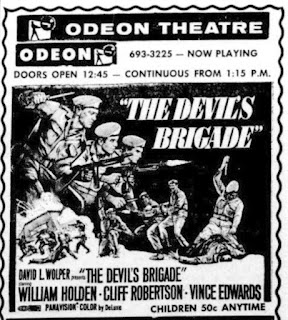

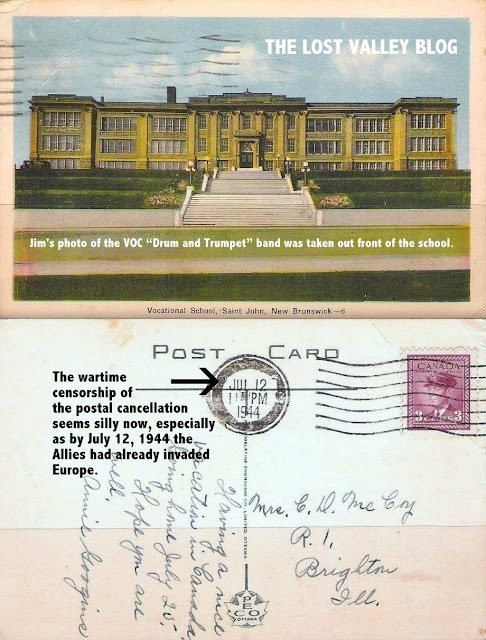
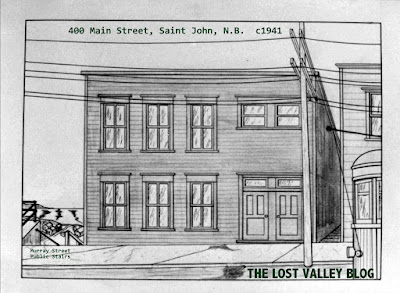
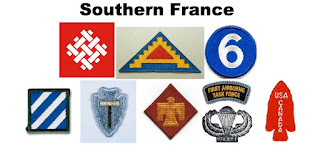
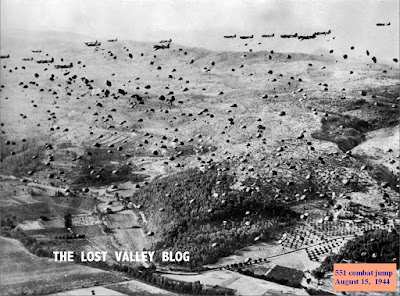
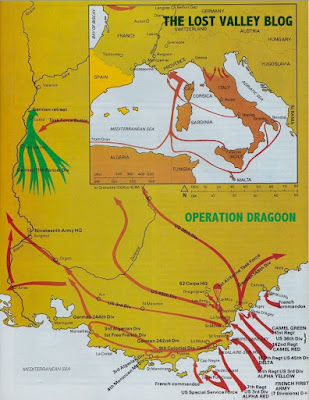




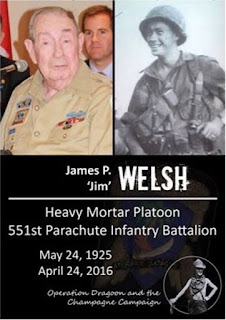

Add a comment